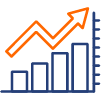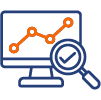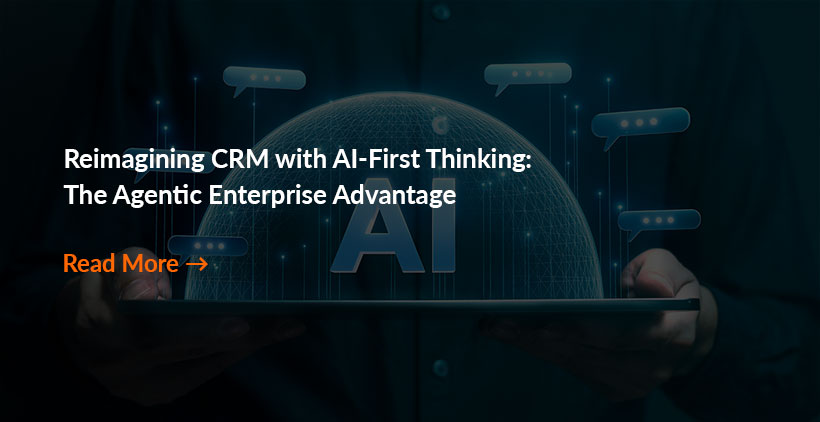
Big data is reinventing strategic decisions across industries. With the help of structured data analysis, enterprises can now identify growth opportunities faster, accelerate innovation, differentiate their products or services, and manage risk and costs better. A well-known example is Walmart, which applies advanced analytics algorithms to combine its sales data with external data to reinforce its everyday low-price (EDLP) strategy. The company can forecast demand in granular micro-pockets. It leverages data-based insights to adjust its inventory and customer service levels at different times, effectively addressing buyers’ needs and lowering its cost base.
Types of data analytics to improve decision-making
The domain of data analytics includes a wide range of applications suitable for different business use cases. CriticalRiver broadly divides them into four categories:

Descriptive analytics
As the foundational layer of data studies, descriptive analytics involves delving into information pools to understand past and current events. It is conducted to know “What happened and what is happening” to make customer-centric and profitable business plans. Enterprises can use descriptive analytics to visualize and summarize data trends, getting the context required to evaluate their markets and identify the potential areas of threats and opportunities.
Companies using descriptive analytics can create reports and dashboards to get a clear overview of their business performance. A gist of historical and recent data helps decision-makers determine patterns and outliers that are valuable inputs for future actions.

Diagnostic analytics
While descriptive analytics records events, diagnostic analytics explains why specific trends occurred, uncovering the root cause of issues and helping organizations take corrective measures.
Diagnostic analytics includes advanced statistical techniques, hypothesis testing, and data mining to determine relationships across variables. It can help realize why sales declined or orders were not fulfilled in time in a particular region, allowing an organization to adjust its marketing strategies or supply chain management accordingly. Power BI and Tableau are two commonly used data visualization tools to represent data graphically using diagnostic analytics.

Predictive analytics
Predictive analytics harnesses historical data to build models and forecast future events. While predicting the future is impossible, predictive analytics helps identify what might be vital and drive proactive decision-making.
Companies can use tools such as machine learning algorithms and statistical models such as decision trees, random forests, and logistic regression to predict demand, churn, and even detect fraud. Additionally, they can elevate their marketing, sales, and internal operations while allocating resources based on predictive analytics insights.

Prescriptive analytics
Prescriptive analytics recommend actions for specific outcomes. Businesses can use this AI-assisted technique to make informed decisions aligning with their marketing, inventory management, and supply chain management goals. Predictive analytics also improves resource allocation, enabling users to enhance contingency planning.
Prescriptive analytics also help evaluate multiple scenarios and suggest the best course of action, especially for long-term planning decisions. It can also simulate the impact of supply shortages or transportation disruptions to provide strategies to minimize the effects of such risks.
Ways to make data-driven decisions
Within the kinds of data analytics described above, organizations can use different elements and methods to reach the decisions they need to make. These include:

Text analytics
Text analytics or text mining or natural language processing (NLP) analyzes unstructured textual data in documents, emails, social media posts, and customer reviews to provide actionable insights through sentiment analysis, topic modeling, and named entity recognition to understand customer expectations better.

Spatial analytics
It deals with location-specific data and is therefore essential for companies whose operations – retail, hospitality, logistics, urban planning – and revenue are impacted by location. Geographic Information Systems (GIS) are commonly used for spatial analytics, enabling organizations to identify key customer regions and new markets, optimize supply chain management, improve delivery routes, and manage disasters.

Cluster analytics
Clustering or segmentation analysis categorizes data points with shared characteristics to reveal hidden patterns and relationships within large datasets. Businesses leverage it to understand customer segments and market trends and identify inefficiencies. They can customize sales strategies, optimize products and services, and execute data-driven decisions, boosting overall performance.
The Road Ahead
With many ways to collect, segment, and interpret raw data, companies can gain deep insights into customer behavior, economic forces, industry patterns, and operational efficacy. The knowledge of these factors’ trajectories helps them tailor their strategic plans and respond proactively to customer expectations. A data-backed approach optimizes their decision-making abilities and opens new doors to growth and sustained competitive advantage on dynamic market landscapes.




